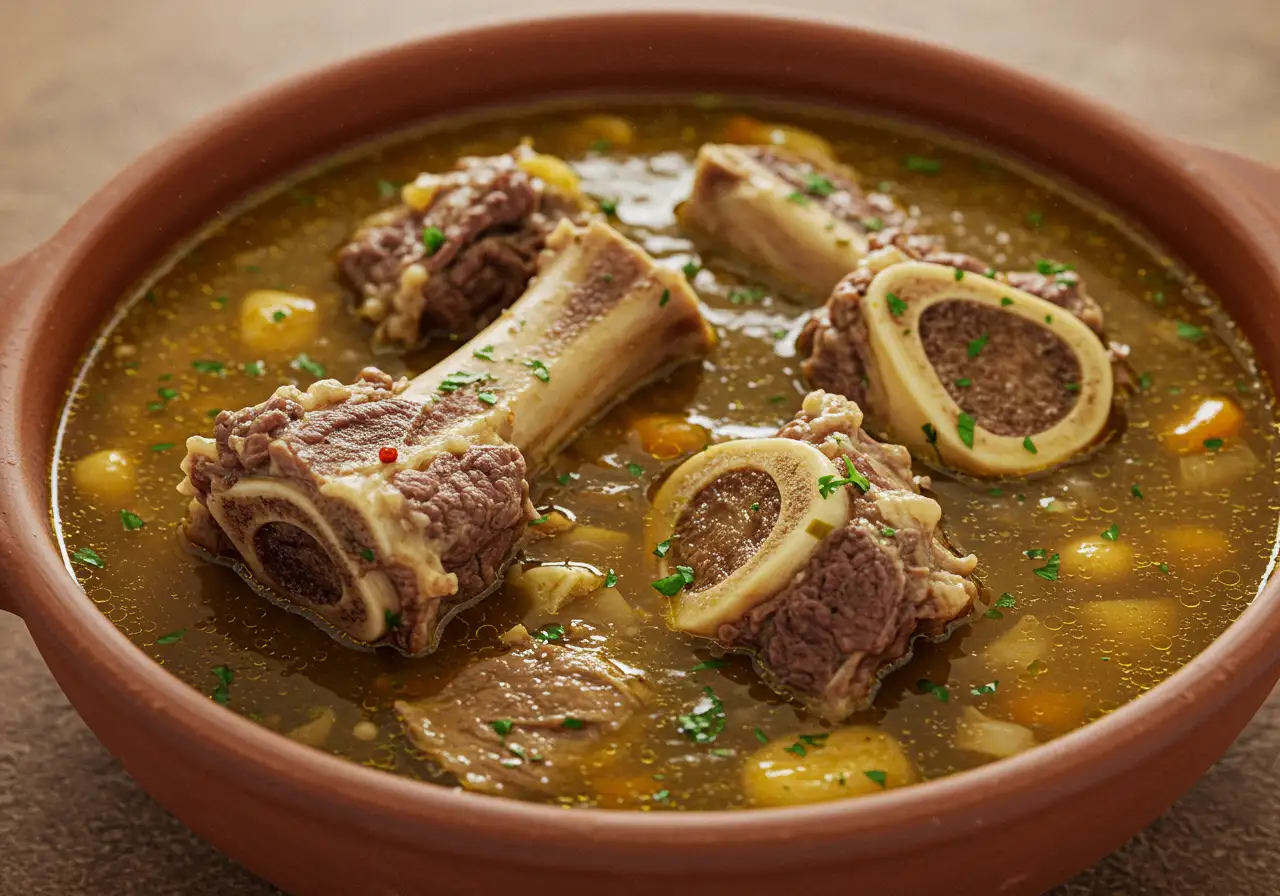Soup bones may seem like humble kitchen scraps, but they’re actually one of the best-kept secrets to making deeply flavorful, healthy, and cost-effective meals. Whether you’re simmering beef bones for rich bone broth or crafting a slow-cooked stew from scratch, soup bones unlock a world of culinary magic. In this guide, we’ll explore what soup bones are, their nutritional power, the best cooking techniques, and how to make the most of every part—from marrow to meat.
Looking for inspiration? Try this energy-boosting recipe with Brazilian flair to keep your meals flavorful and functional.
What is a Soup Bone?
What Defines a True Soup Bone?
A soup bone typically refers to a cut of animal bone—most often beef, or chicken—that contains some meat, cartilage, connective tissue, and sometimes marrow. Unlike a clean bone you’d find for a dog, soup bones are prized for the flavor and nutrients they impart when simmered slowly in water.
The best soup bones are rich in collagen and gelatin-producing components. As they cook, they break down and infuse liquid with deep flavor and body. This is what gives traditional broths and stocks their rich mouthfeel and golden color.
You’ll often find soup bones sold as:
- Beef knuckles
- Neck bones
- Shank bones
- Oxtail
- Marrow bones
- Poultry carcasses (chicken or turkey)
These bones aren’t just flavorful—they’re functional in cooking.
Types of Bones Commonly Used in Soups (Marrow, Knuckle, Neck, etc.)
| Bone Type | Common Animal | Best For | Flavor Level | Contains Marrow? |
|---|---|---|---|---|
| Marrow Bones | Beef | Rich broths, sipping broths | High | Yes |
| Knuckle Bones | Beef | Gelatinous stocks | Medium | Sometimes |
| Neck Bones | Pork/Beef | Meaty soups, stews | High | No |
| Shank Bones | Beef | Slow-cooked soups, osso buco | High | Yes |
| Poultry Carcass | Chicken/Turkey | Light broths | Medium | No |
Soup bones often blend both marrow and meaty sections, making them ideal for creating a nutrient-dense broth that’s both satisfying and beneficial to your health.
Don’t miss our Coffee Loophole Recipe for another creative way to sneak nutrition into your daily routine.
Nutritional Value of Soup Bones
Rich in Collagen, Calcium, and Minerals
Soup bones aren’t just flavorful—they’re incredibly nutrient-dense. When simmered over low heat for several hours, the bones and connective tissue release vital nutrients into the broth. Here’s what you’re really getting in every spoonful:
- Collagen & Gelatin: Collagen breaks down into gelatin during cooking, supporting joint health, skin elasticity, and gut lining repair.
- Calcium, Magnesium, and Phosphorus: These minerals are essential for bone strength and nerve function.
- Glucosamine & Chondroitin: Naturally occurring in cartilage, these compounds promote joint mobility and can help ease arthritis symptoms.
- Amino Acids: Such as glycine and proline, which aid muscle recovery and immune health.
The longer the bones simmer, the more nutrients are extracted. That’s why bone broths made from soup bones are often referred to as “liquid gold” in the health food world.
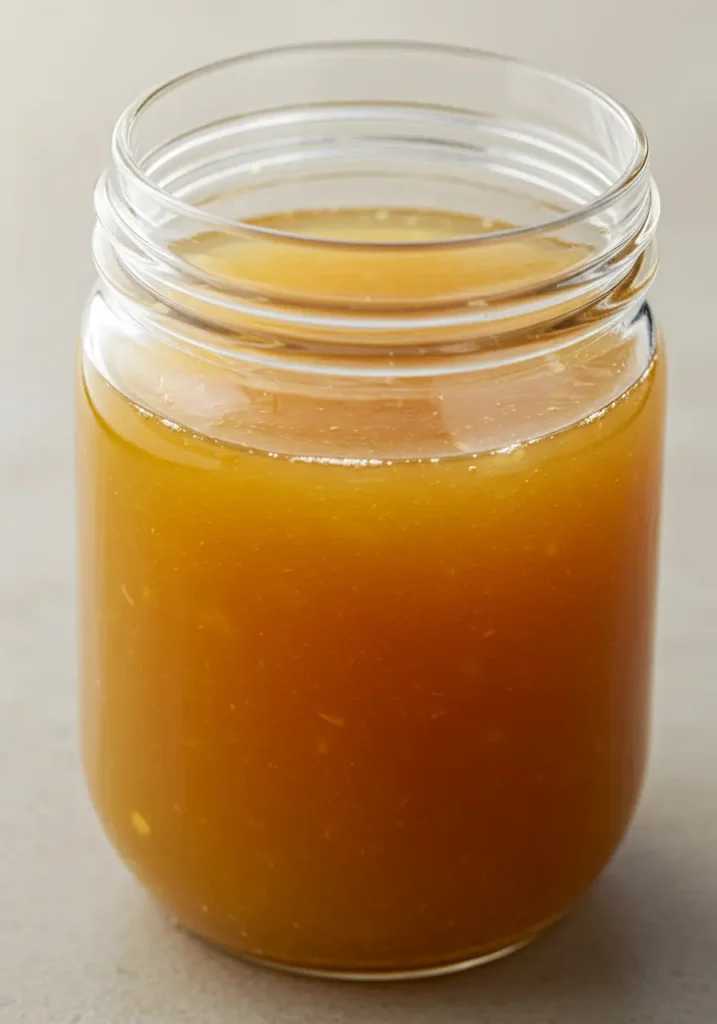
Bone Broth Benefits Backed by Science
Bone broth—made using soup bones—has gained serious traction for its health benefits. Studies show that the gelatin and amino acids in bone broth can help:
- Reduce joint pain and inflammation
- Support digestive health by healing the gut lining
- Improve skin hydration and reduce wrinkles
- Promote better sleep due to high levels of glycine
- Boost immunity with minerals and collagen peptides
Many holistic health experts recommend incorporating soup bone broth into daily routines as a low-calorie, high-nutrient superfood.
Check out Terra Massoud Recipe for another robust, flavorful dish packed with ingredients that nourish your body.
Best Uses for Soup Bones in Cooking
Soup Bone Uses in Broth, Soups, and Stews
Soup bones aren’t just for making broth—they’re versatile and can be used across a variety of dishes. Here are some of the most common and effective ways to use them:
1. Bone Broth
The most popular use for soup bones is simmering them into a nutrient-rich bone broth. It’s the base for soups, sipping broths, and sauces. Simmer for 12–24 hours for max nutrient extraction.
2. Hearty Soups
Toss soup bones into slow-simmering recipes like beef barley soup, vegetable beef stew, or even Asian noodle soups for intense flavor and depth.
3. Flavor Base for Gravy & Sauces
Boil soup bones with aromatics like onions, garlic, and herbs to create a deep-flavored stock that can be reduced into gravies, demi-glaces, and sauces.
4. Stews & Braises
Some soup bones come with a good amount of meat. In dishes like osso buco or beef stew, the bone and meat cook together, enhancing both taste and texture.
Don’t limit yourself—these bones can be your flavor foundation in dozens of dishes.
Flavor Enhancing Techniques for Soup Bone Cooking
To get the best taste out of your soup bones, follow these chef-approved tricks:
✅ Roast Before You Boil
Roasting soup bones at 400°F for 30–45 minutes caramelizes the exterior and adds a rich umami depth to your broth.
✅ Add Aromatics
Boost flavor by simmering bones with:
- Onion
- Celery
- Carrots
- Bay leaves
- Peppercorns
- A splash of apple cider vinegar (helps extract minerals from the bones)
✅ Simmer Low and Slow
For deep flavor and nutrient release, simmer bones for 12–24 hours. Avoid boiling—it causes emulsification and cloudy broth.
✅ Skim Frequently
Skim off the foam that rises to the top during cooking. It helps keep your broth clear and clean-tasting.
How to Make Soup Bone Broth from Scratch
Step-by-Step Instructions for Beginners
Making soup bone broth at home isn’t complicated—but it does require patience. Here’s how to do it right:
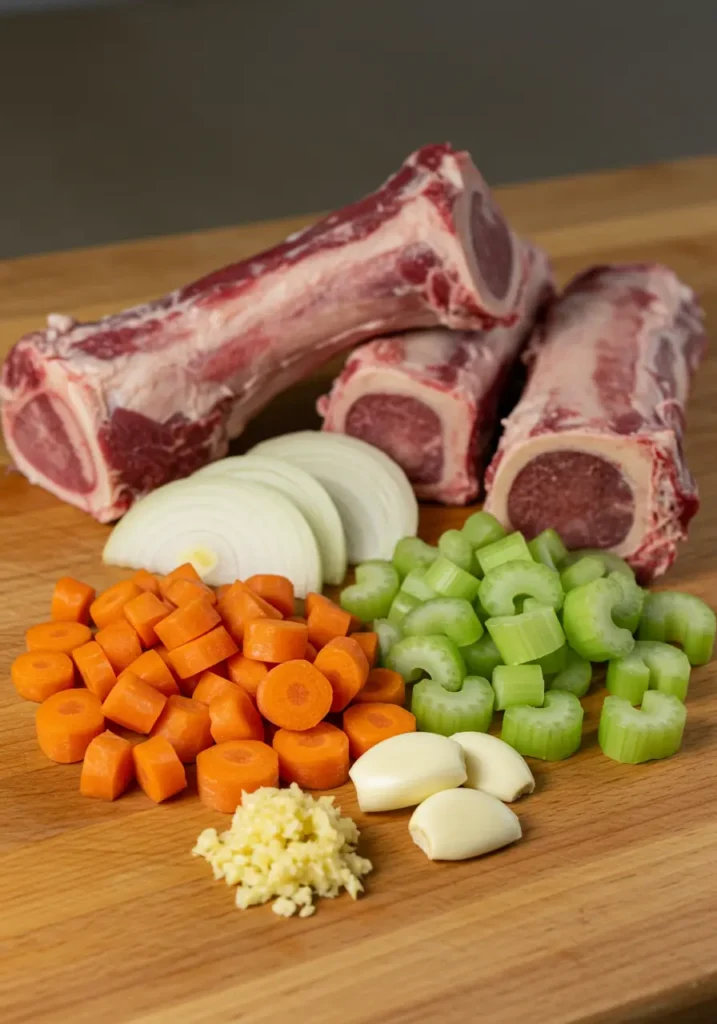
Step 1: Choose Your Bones
Start with high-quality bones—beef marrow, knuckle bones, or neck bones are ideal. You can use a mix of types for better flavor and nutrient content.
Step 2: Roast the Bones (Optional but Recommended)
Preheat your oven to 400°F (200°C). Spread bones on a baking sheet and roast for 30–45 minutes until deeply browned. This adds depth and richness to your broth.
Step 3: Transfer to a Stockpot or Slow Cooker
Place the roasted bones in a large stockpot or slow cooker. Add just enough cold water to cover them completely (about 10–12 cups).
Step 4: Add Aromatics and Acid
Drop in:
- 2 chopped carrots
- 2 chopped celery stalks
- 1 onion (halved)
- 3 garlic cloves
- 1 tbsp apple cider vinegar (helps pull minerals from the bones)
Add herbs like thyme, parsley, and bay leaves for more flavor.
Step 5: Simmer Low and Slow
Bring the pot to a low boil, then reduce to a simmer. Let it go for:
- 12–24 hours for beef bones
- 8–12 hours for poultry bones
Use a lid to minimize evaporation, and skim foam every few hours.
Step 6: Strain and Cool
Once the broth is rich and dark, strain it through a fine mesh sieve. Let it cool slightly, then refrigerate.
You’ll notice a jelly-like consistency once it’s cold—that’s the collagen!
Tools and Ingredients You’ll Need
Here’s a quick list to make preparation easy:
| Item | Purpose |
|---|---|
| Roasting pan | For pre-browning bones |
| Large stockpot or slow cooker | For long, even simmering |
| Fine mesh strainer | To remove bones and veggies |
| Mason jars or freezer containers | For broth storage |
| Apple cider vinegar | Helps extract minerals from bones |
| Vegetables (onion, carrots, celery) | Add flavor and nutrients |
Pro Tip: Once the broth is chilled, a layer of fat will rise to the top. You can scoop this off and use it for cooking (beef tallow), or mix it back in for added richness.
Can You Eat Soup Bone Meat?
Edible Parts and Safety Tips
Absolutely—you can eat the meat from soup bones. In fact, it’s often one of the best parts. While soup bones aren’t sold primarily for their meat content, many cuts—like beef shanks, neck bones, or oxtail—come with flavorful, tender meat that falls right off the bone after slow cooking.
Here’s what’s commonly edible on soup bones:
- Attached meat: Found on neck bones, short ribs, and oxtail. After simmering, this meat becomes juicy and fork-tender.
- Marrow: Found inside beef marrow bones. It’s nutrient-dense, buttery, and considered a delicacy in many cuisines.
- Cartilage and soft tissue: Found in knuckles and joint bones. These break down into gelatin, which adds thickness to the broth and is great for joint and gut health.
🛑 Safety tip: Always ensure soup bones are cooked thoroughly before consuming any meat. Avoid eating cartilage or marrow raw.
Best Practices for Using the Meat on Soup Bones
Once your soup or broth is done, don’t throw those bones out just yet. Instead, remove and repurpose the meat with these ideas:
✅ Shred It for Soups and Stews
After simmering, the meat is incredibly tender. Just pull it off with a fork and add it back into your soup or stew for an extra protein boost.
✅ Use It in Tacos or Sandwiches
The slow-cooked meat from beef bones is perfect for shredded beef tacos, sliders, or even open-faced sandwiches.
✅ Make a Bone Marrow Spread
Scoop out cooked marrow and mix it with herbs and sea salt. Spread it on toasted bread or crackers—it’s a rich, savory treat.
✅ Create Pet Treats (If Safe)
If you’re not using the meat, consider giving some of the cooked, de-boned portions to your pets (check with your vet first).
Eating the meat from soup bones not only reduces waste—it adds more value to each batch of broth you make.
Are Soup Bones the Same as Marrow Bones?
Differences in Texture, Usage, and Flavor
Many people think soup bones and marrow bones are interchangeable, but there are key differences you should know when choosing them for your recipe.
| Feature | Soup Bones | Marrow Bones |
|---|---|---|
| Composition | Bone + meat + cartilage | Bone with fatty, soft marrow center |
| Texture | Meaty and connective tissue-rich | Fatty, buttery, soft |
| Flavor Profile | Savory, hearty, collagen-rich | Rich, deep umami, slightly fatty |
| Ideal Use | Stock, broth, soups, stews | Roasted marrow, sipping broths |
| Nutrients | Collagen, protein, minerals | Healthy fats, iron, Vitamin A |
In short, all marrow bones can be soup bones, but not all soup bones contain marrow. Soup bones are more general and may include cuts like:
- Knuckles
- Neck bones
- Shanks
- Ribs
Whereas marrow bones are specifically femur or long bones that contain the fatty center—marrow.
When to Use Soup Bones vs Marrow Bones
So, when should you use each one?
✅ Use Soup Bones when:
- You want a balanced broth with both meatiness and gelatin
- You’re making hearty soups, stews, or multi-purpose stock
- You’re cooking for nutrition—collagen, cartilage, and amino acids
✅ Use Marrow Bones when:
- You want a rich sipping broth
- You plan to roast marrow for spreads
- You want to add healthy fats and minerals to a dish
Pro Tip: The best bone broths usually combine both soup bones and marrow bones—giving you the full range of nutrients, flavor, and texture.
Up next is Part 7: Where to Buy or Source Quality Soup Bones, including the pros and cons of local butchers vs supermarkets vs online. Ready for it?
Where to Buy or Source Quality Soup Bones
Local Butchers vs Supermarkets vs Online
Not all soup bones are created equal. Where you get them from can impact both the taste and nutritional value of your broth. Here’s a breakdown of the most common sources:
✅ Local Butcher Shops
Local butchers often provide fresh, high-quality cuts. You can also ask for a specific mix—like marrow + knuckle bones—and they’ll often cut them to size.
Pros:
- Typically grass-fed or pasture-raised options
- Custom cuts and suggestions from experts
- Support small businesses
Cons:
- Can be more expensive than grocery stores
- Availability may vary
✅ Supermarkets
Larger grocery stores often carry frozen soup bones, usually beef or pork. These are convenient but may not always be the highest quality.
Pros:
- Easy to find
- Budget-friendly
- Pre-packaged for convenience
Cons:
- Often from grain-fed animals
- Less control over the type of bones
✅ Online Retailers
Online marketplaces and farms offer bulk soup bones, including grass-fed and organic options. You can often choose from specialty cuts like wild game or heritage breed.
Pros:
- Access to premium and exotic bones
- Bulk savings and delivery to your door
Cons:
- Shipping costs can be high
- Must plan ahead due to delivery times
How to Choose the Best Bones for Soups
When selecting soup bones, look for the following traits:
| Feature | What to Look For |
|---|---|
| Color | Light pink to deep red, not gray or dry |
| Marrow Content | Bones with visible, healthy-looking marrow |
| Meatiness | Bits of meat or cartilage attached |
| Cut Size | About 2–3 inches long for even cooking |
| Source | Grass-fed or organic if possible |
Also, mixing bone types gives your broth more flavor and texture. A blend of marrow, knuckle, and meaty bones is ideal.
Need some culinary inspiration while planning your bone shopping? Check out our Terra Massoud Recipe—a deep-flavored dish that complements any bone broth base.
Storage and Shelf Life Tips
Freezing, Refrigerating, and Reusing Soup Bones
Proper storage of soup bones helps preserve their flavor, nutrients, and safety—especially if you’re buying in bulk or prepping ahead. Here’s how to do it right:
✅ Refrigeration (Short-Term)
- How long? Up to 3 days in the fridge
- Store in a sealed glass or BPA-free plastic container
- Best for bones you’ll use within a few days for broth or stews
✅ Freezing (Long-Term)
- How long? Up to 6 months
- Wrap bones tightly in freezer-safe bags or vacuum seal them
- Label with the date and bone type (e.g., “Beef Marrow, Jan 2025”)
Pro Tip: Blanch raw bones before freezing to reduce bacteria and extend shelf life. It also removes impurities that can cloud your broth later.
✅ Reusing Soup Bones
Yes, soup bones can be reused—especially for multiple broth batches. After the first round:
- Re-simmer bones a second time for a lighter, but still flavorful broth
- Add fresh aromatics to refresh the taste
- Discard bones when they become soft, brittle, or hollow
Signs of Spoilage and How to Avoid Waste
Soup bones are resilient, but they’re not immune to spoilage. Here’s what to watch for:
| Spoilage Sign | What It Means | Action To Take |
|---|---|---|
| Sour or rancid smell | Spoiled fats or bacteria | Discard immediately |
| Slimy texture | Bacterial growth | Do not use |
| Grayish-green color | Decomposition or mold | Unsafe—throw away |
| Sticky container lid | Gas buildup from spoilage bacteria | Discard contents safely |
Avoid waste by batch-cooking bone broth and freezing it in ice cube trays, quart containers, or mason jars (leave room for expansion). That way, you always have a ready-to-use flavor boost.
Creative Recipes Using Soup Bones
3 Easy and Flavorful Soup Bone Recipes
Here are three go-to recipes that showcase the versatility and rich flavor of soup bones—from comforting classics to bold global fusions.
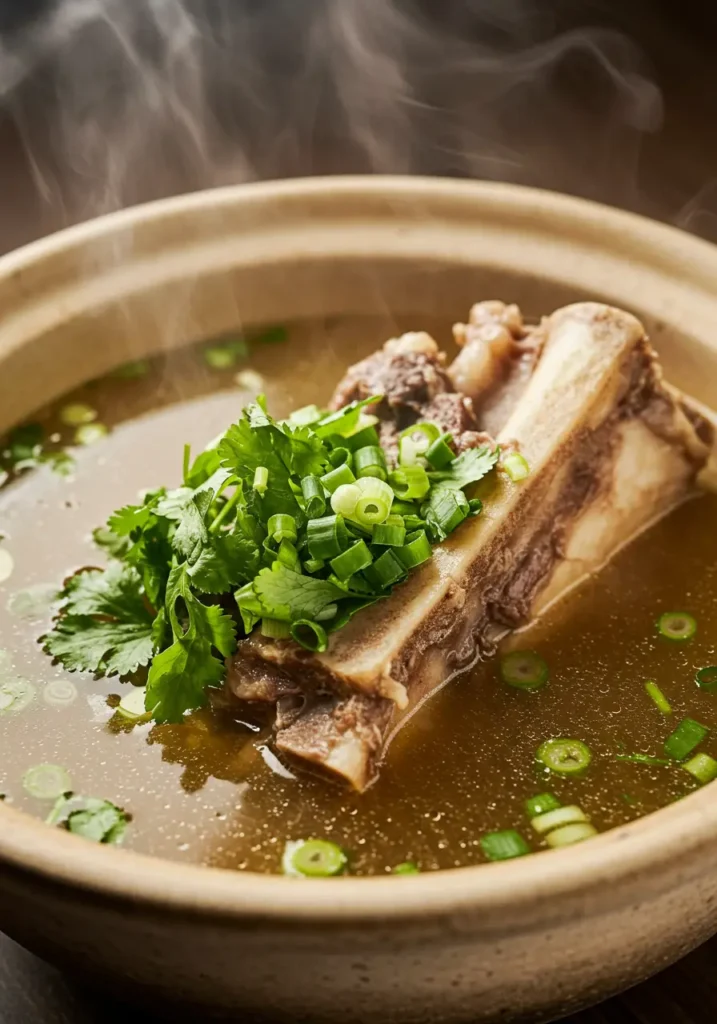
🥣 1. Classic Beef Bone Broth
Ingredients:
- 3–4 lbs beef soup bones (mix of marrow, knuckle, and meaty bones)
- 2 carrots, chopped
- 2 celery stalks, chopped
- 1 onion, halved
- 2 tbsp apple cider vinegar
- Water to cover
- Salt, pepper, bay leaves
Instructions:
- Roast bones at 400°F for 40 minutes.
- Transfer to a pot with vegetables and vinegar. Add water to cover.
- Bring to a low boil, then simmer uncovered for 12–24 hours.
- Strain, cool, and store.
Use it for: Sipping broth, cooking grains, or as a soup base.
🍲 2. Hearty Vegetable Beef Soup with Bone Meat
Ingredients:
- 2 lbs meaty soup bones (neck or shank)
- 1 cup diced carrots
- 1 cup chopped potatoes
- ½ cup corn
- ½ cup green beans
- 6 cups broth (from your bone broth!)
- 2 garlic cloves, minced
- 1 tsp thyme, 1 tsp rosemary
Instructions:
- Simmer soup bones with aromatics for 2 hours. Remove bones and shred meat.
- Add veggies and simmer another 30 minutes.
- Return shredded meat, season, and serve.
Pro Tip: Pairs well with crusty bread for a filling, one-bowl meal.
🌍 3. Asian-Inspired Ginger Garlic Bone Soup
Ingredients:
- 3 lbs beef or pork soup bones
- 1 thumb ginger, sliced
- 5 garlic cloves, smashed
- 2 tbsp soy sauce
- 1 tbsp fish sauce
- 1 green onion, chopped
- Fresh cilantro (optional)
Instructions:
- Roast bones, then simmer with garlic and ginger for 10 hours.
- Add soy sauce, fish sauce, and salt to taste.
- Top with green onion and cilantro.
Use it for: Ramen base, pho-style noodles, or sipped hot for an immunity boost.
Looking for something bold and nourishing? Don’t miss our Brazilian Mounjaro Recipes to pair global energy with traditional nutrition.
International Soup Traditions That Use Soup Bones
Soup bones have been used across cultures for centuries—because they stretch food and deliver unbeatable flavor.
| Cuisine | Dish | Key Bone Used |
|---|---|---|
| Vietnamese | Pho | Beef marrow + knuckle |
| Korean | Seolleongtang (ox bone soup) | Beef leg bones |
| Eastern European | Borscht, beef broth base | Neck or rib bones |
| Mexican | Caldo de Res | Beef shank bones |
| American | Pot roast soup, bone stock | Soup/marrow mix |
These recipes prove soup bones are more than leftovers—they’re the backbone of timeless, comforting meals around the world.
FAQs
What is considered a soup bone?
A soup bone is any cut of animal bone—commonly from beef, pork, or poultry—that’s used to make broth or stock. It often includes a combination of marrow, meat, cartilage, and connective tissue, which break down during slow cooking to release nutrients and flavor. Cuts like beef knuckles, shanks, oxtails, and neck bones are all examples of soup bones.
What are soup bones good for?
These bones serve multiple purposes in the kitchen, such as:
Making homemade broths
Creating hearty soups and stews
Enhancing sauces and gravies
They deliver rich nutrients like collagen, calcium, and amino acids—beneficial for gut health, joints, and immune function. The flavor they add is far deeper than store-bought stock.
Can you eat soup bone meat?
Yes! Many soup bones—especially those from beef necks, pork shanks, or oxtails—come with tender, flavorful meat. After long simmering, the meat easily shreds off the bone and can be added back into your soup, used in tacos, or served as a protein side. The marrow inside some bones is also edible and highly nutritious.
Are soup bones the same as marrow bones?
Not quite. Marrow bones are a more specific cut—usually from leg or femur bones—containing a rich, fatty center. The broader category of bones used in recipes includes those with meat and cartilage, too. Combining both types offers the best mix of flavor, collagen, and nutrients.
Conclusion
Soup bones are one of the most underrated yet powerful ingredients in the kitchen. Whether you’re crafting a rich bone broth, simmering a soul-warming stew, or diving into global comfort dishes, soup bones offer flavor, nutrients, and versatility like few other ingredients can.
From understanding the types of soup bones to unlocking their full nutritional value and even knowing where to buy and how to store them—this guide has you covered. Next time you see a bag of bones at the butcher, you’ll know exactly what to do.
Don’t miss our Smoked Chicken Thighs recipe to pair perfectly with any of your homemade broths.
Print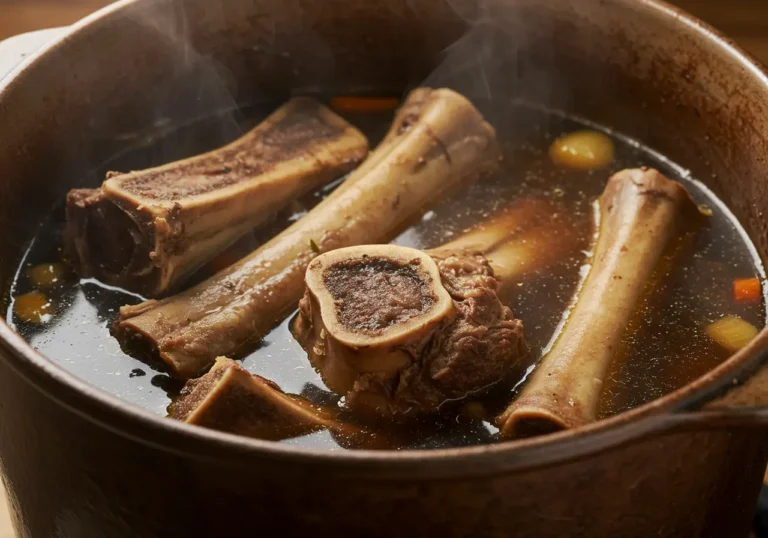
Soup Bone: The Complete Guide to Flavorful, Nutrient-Rich Meals
Rich, nourishing beef bone broth made with roasted soup bones, vegetables, and herbs. Perfect for sipping or as a base for soups, stews, and sauces.
- Total Time: 12 hours 10 minutes
- Yield: 8 cups 1x
Ingredients
- 3–4 lbs beef soup bones (marrow, knuckle, or shank)
- 2 carrots, chopped
- 2 celery stalks, chopped
- 1 large onion, halved
- 3 garlic cloves, crushed
- 2 tablespoons apple cider vinegar
- 2 bay leaves
- 10–12 cups cold water
- Salt and pepper to taste
Instructions
- Preheat oven to 400°F (200°C). Place bones on a baking sheet and roast for 40 minutes until golden brown.
- Transfer roasted bones to a large stockpot or slow cooker. Add chopped vegetables, garlic, bay leaves, and vinegar.
- Add water to fully cover the bones. Bring to a boil, then reduce to a low simmer.
- Simmer uncovered for 12–24 hours. Skim foam occasionally for a clear broth.
- Strain the broth through a fine mesh sieve into a clean container.
- Cool and refrigerate. Skim solid fat once chilled, or use as-is. Store in the fridge up to 5 days or freeze for up to 6 months.
Notes
- For richer flavor, add tomato paste to the bones before roasting.
- Combine multiple bone types (marrow + knuckle) for better texture and nutrient density.
- Use broth as a base for risottos, soups, or even to cook rice or quinoa.
- Prep Time: 10 minutes
- Cook Time: 12 hours
- Category: Broth / Soup Base
- Method: Simmering
- Cuisine: American, Traditional
- Diet: Gluten Free
Nutrition
- Serving Size: 1 cup (240ml)
- Calories: 45 kcal
- Sugar: 0.5 g
- Sodium: 180 mg
- Fat: 1.5 g
- Saturated Fat: 0.6 g
- Unsaturated Fat: 0.9 g
- Trans Fat: 0 g
- Carbohydrates: 1.2 g
- Fiber: 0 g
- Protein: 6–9 g
- Cholesterol: 10 mg
Keywords: Soup bone, bone broth, beef bones, homemade broth, collagen-rich soup, beef soup stock

